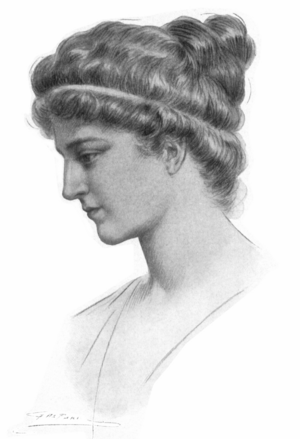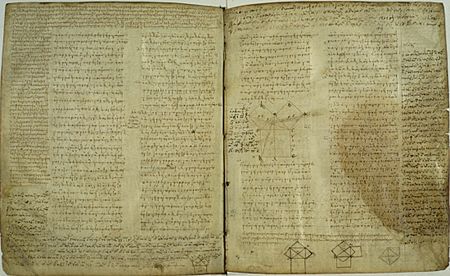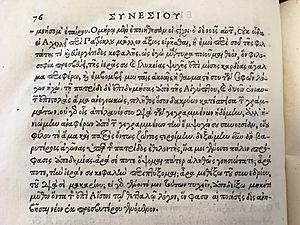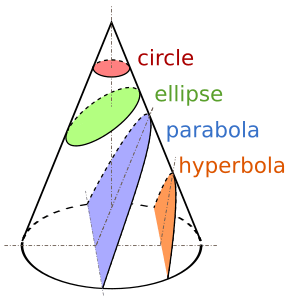Hypatia facts for kids
Quick facts for kids
Hypatia
|
|
|---|---|

Fictional portrait of Hypatia
|
|
| Born | c. 350–370 AD |
| Died | March 415 AD (aged 45–65) Alexandria, Province of Egypt, Eastern Roman Empire
|
| Era | Ancient philosophy |
| Region | Western philosophy |
| School | Neoplatonism |
|
Main interests
|
|
|
Influences
|
|
|
Influenced
|
|
Hypatia (born c. 350–370; died 415 AD) was a neoplatonist philosopher, astronomer, and mathematician who lived in Alexandria, Egypt, then part of the Eastern Roman Empire. Hypatia was renowned in her own lifetime as a great teacher and a wise counselor.
Contents
Upbringing

Hypatia was the daughter of the mathematician Theon of Alexandria (c. 335 – c. 405 AD). Theon was the head of a school called the "Mouseion". Theon's school was exclusive, highly prestigious, and doctrinally conservative. Although he was widely seen as a great mathematician at the time, Theon's mathematical work has been deemed by modern standards as essentially "minor", "trivial", and "completely unoriginal". His primary achievement was the production of a new edition of Euclid's Elements, in which he corrected scribal errors that had been made over the course of nearly 700 years of copying. Theon's edition of Euclid's Elements became the most widely used edition of the textbook for centuries and almost totally supplanted all other editions.
Nothing is known about Hypatia's mother. Hypatia's exact year of birth is still under debate. It is most likely that Hypatia was born around 370.
Career
Alexandria, her home city, was regarded as second only to Athens as the philosophical capital of the Greco-Roman world. Hypatia taught students from all over the Mediterranean. She lectured on the writings of Plato and Aristotle. She walked through Alexandria in a tribon, a kind of cloak associated with philosophers, giving impromptu public lectures.

Although Hypatia herself was a pagan, she was tolerant of Christians. In fact, every one of her known students was Christian. One of her most prominent pupils was Synesius of Cyrene, who went on to become a bishop of Ptolemais (now in eastern Libya) in 410.
Philostorgius, another Christian historian, who was also a contemporary of Hypatia, states that she excelled her father in mathematics. Hypatia was "exceedingly beautiful and fair of form", but nothing else is known regarding her physical appearance and no ancient depictions of her have survived.
Later life and death
Hypatia established great influence with the political elite in Alexandria.
Towards the end of her life, Hypatia advised Orestes, the Roman prefect of Alexandria, who was in the midst of a political feud with Cyril, the bishop of Alexandria. Rumors spread accusing her of preventing Orestes from reconciling with Cyril and, in March 415 AD, she was murdered by a mob of Christians led by a lector named Peter.
Hypatia's murder shocked the empire. She was declared a "martyr for philosophy". Although no concrete evidence linking Cyril to the murder of Hypatia was ever discovered, it was widely believed that he had ordered it. Even if Cyril had not directly ordered the murder himself, his smear campaign against Hypatia had inspired it.
Works
Hypatia has been described as a universal genius, but she was probably more of a teacher and commentator than an innovator. No evidence has been found that Hypatia ever published any independent works on philosophy and she does not appear to have made any groundbreaking mathematical discoveries.

- Hypatia is now known to have edited the existing text of Book III of Ptolemy's Almagest. Her contribution is thought to be an improved method for the long division algorithms needed for astronomical computation.

- She wrote a commentary on Diophantus's thirteen-volume Arithmetica, which had been written sometime around the year 250 AD.
- Hypatia also wrote a commentary on Apollonius of Perga's work on conic sections, but this commentary is no longer extant.
- She created an "Astronomical Canon"; this is believed to have been either a new edition of the Handy Tables by the Alexandrian Ptolemy or the commentary on his Almagest.
Interesting facts about Hypatia

- Hypatia is the first female mathematician whose life is reasonably well recorded.
- She was a prominent thinker in Alexandria where she taught philosophy and astronomy.
- Many modern scholars also believe that Hypatia may have edited the surviving text of Ptolemy's Almagest
- Hypatia constructed astrolabes and hydrometers, but did not invent either of these, which were both in use long before she was born.
- She was tolerant towards Christians and taught many Christian students.
- Ancient sources record that Hypatia was widely beloved by pagans and Christians alike.
- Scholars believe she was part of the basis for the legend of Saint Catherine of Alexandria.
- During the Age of Enlightenment, she became a symbol of opposition to Catholicism.
- In the twentieth century, Hypatia became seen as an icon for women's rights.
- Hypatia was never married because she said she was “wedded to the truth”.
Images for kids
-
Drawing from the Alexandrian World Chronicle depicting Pope Theophilus of Alexandria, gospel in hand, standing triumphantly atop the Serapeum in 391 AD
-
Icon of Saint Catherine of Alexandria from Saint Catherine's Monastery in Sinai, Egypt. The legend of Saint Catherine is thought to have been at least partially inspired by Hypatia.
-
The eighteenth-century English Deist scholar John Toland used Hypatia's death as the basis for an anti-Catholic polemic, in which he changed the details of her murder and introduced new elements not found in any of his sources in order to portray Cyril in the worst possible light.
See also
 In Spanish: Hipatia para niños
In Spanish: Hipatia para niños




